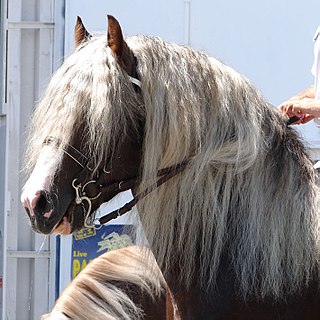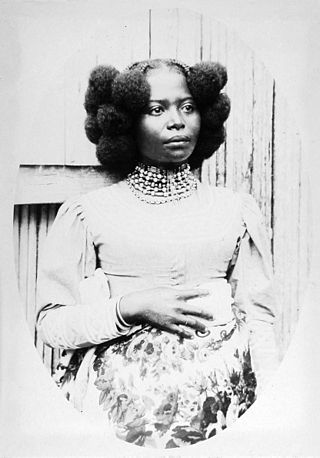Braided hair is hair that has been tied into braids. Braided hair may also refer to:
- "Braided Hair", a kind of Coronet large cent
- "Braided Hair", a song from the 2002 1 Giant Leap album 1 Giant Leap
Braided hair is hair that has been tied into braids. Braided hair may also refer to:

A hairstyle, hairdo, haircut or coiffure refers to the styling of hair, usually on the human head but sometimes on the face or body. The fashioning of hair can be considered an aspect of personal grooming, fashion, and cosmetics, although practical, cultural, and popular considerations also influence some hairstyles.
Bush commonly refers to:

A braid is a complex structure or pattern formed by interlacing three or more strands of flexible material such as textile yarns, wire, or hair. The simplest and most common version is a flat, solid, three-stranded structure. More complex patterns can be constructed from an arbitrary number of strands to create a wider range of structures. The structure is usually long and narrow with each component strand functionally equivalent in zigzagging forward through the overlapping mass of the others. It can be compared with the process of weaving, which usually involves two separate perpendicular groups of strands.
1 Giant Leap is a British electronic music duo consisting of the two principal artists, Jamie Catto and Duncan Bridgeman.

The mohawk is a hairstyle in which, in the most common variety, both sides of the head are shaven, leaving a strip of noticeably longer hair in the center. Mohawk hairstyles have existed for thousands of years. As of the 21st century, they are most commonly associated with punks, or broader non-conformity.

Kiribati competed in the Summer Olympic Games for the first time at the 2004 Summer Olympics in Athens, Greece, from August 13–29, 2004. The country sent three representatives to the Games: two in athletics and one in weightlifting. As of 2012, Meamea Thomas has the best finish of any I-Kiribati athlete in Olympic history. Kiribati did not win medals at these Games.

Cornrows are a style of traditionally three-strand braids, originating in Africa, in which the hair is braided very close to the scalp, using an underhand, upward motion to make a continuous, raised row. Cornrows are often done in simple, straight lines, as the term implies, but they can also be styled in elaborate geometric or curvilinear designs. They are distinct from, but may resemble, box braids, Dutch braids, melon coiffures, and other forms of plaited hair, and are typically tighter than braids used in other cultures.

A French braid, also called a French plait, is a type of braided hairstyle. The three-strand gathered plait includes three sections of hair that are braided together from the crown of the head to the nape of the neck.

In the context of hairstyles, the usage of the term pigtail shows considerable variation. The term may refer to a single braid, but is more frequently used in the plural ("pigtails") to refer to twin braids on opposite sides of the head. Sometimes, the term "pigtails" applies whether or not the hair is braided, but there is not widespread agreement on this.
Traction alopecia is a type of alopecia or hair loss caused by a chronic pulling force being applied to the hair. It commonly results from a person frequently wearing their hair in a particularly tight ponytail, pigtails, or braids with increased likelihood when hair is chemically relaxed as this compromises the hair shaft's tensile strength resulting in hair breakage. Traction alopecia causes a recession of the hairline due to chronic traction, which is characterized by a fringe along the marginal hairline on physical exam. Diagnosis is clinical and treatment directed at cessation of the chronic traction, while cosmeses, with surgical restoration is reserved for severe cases with scarring fibrosis.
Artificial hair integrations, more commonly known as hair extensions, hair weaves, and fake hair add length and fullness to human hair. Hair extensions are usually clipped, glued, or sewn on natural hair by incorporating additional human or synthetic hair. These methods include tape-in extensions, clip-in or clip-on extensions, micro/nano rings, fusion method, weaving method, and wigs.

On horses, the mane is the hair that grows from the top of the neck of a horse or other equine, reaching from the poll to the withers, and includes the forelock or foretop. It is thicker and coarser than the rest of the horse's coat, and naturally grows to roughly cover the neck. Heredity plays a role, giving some horses a longer, thicker mane, and others a shorter, thinner one.

Kinky hair, also known as afro-textured hair, is a human hair texture prevalent in the indigenous populations of many regions with hot climates, mainly sub-Saharan Africa, some areas of Melanesia, and Australia. Each strand of this hair type grows in a repeating pattern of small contiguous kinks. These numerous kinks make kinky hair appear denser than straight, wavy, and curly hair types.

A daenggi (Korean: 댕기) is a traditional Korean ribbon used to tie up and decorate braided hair. According to the History of Northern Dynasties, maidens of Baekje bound their hair at the back and braided it, while a married woman braided her hair into two plaits and secured them to the crown of her head.

The tail of the horse and other equines consists of two parts, the dock and the skirt. The dock consists of the muscles and skin covering the coccygeal vertebrae. The term "skirt" refers to the long hairs that fall below the dock. On a horse, long, thick tail hairs begin to grow at the base of the tail, and grow along the top and sides of the dock. In donkeys and other members of Equus asinus, as well as some mules, the zebra and the wild Przewalski's horse, the dock has short hair at the top of the dock, with longer, coarser skirt hairs beginning to grow only toward the bottom of the dock. Hair does not grow at all on the underside of the dock.

African-American hair or Black hair refers to hair types, textures, and styles that are linked to African-American culture, often drawing inspiration from African hair culture. It plays a major role in the identity and politics of Black culture in the United States and across the diaspora. African-American hair often has a kinky hairy texture, appearing tightly coiled and packed. Black hair has a complex history, culture, and cultural impact, including its relationship with racism.

Crochet braids, also known as latch hook braids, are techniques for braiding hair that involve crocheting synthetic hair extensions to a person's natural hair with a latch hook or crochet hook. While crochet braids are a hybrid of traditional braids, they're considered to be more similar to weaves. This method is associated with African hair styles. Known as a protective style, the technique can assist with hair growth if cared for properly. Crochet braids can be worn straight, curly, twisted, or braided.
The natural hair movement is a movement which aims to encourage people of African descent to embrace their natural, afro-textured hair; especially in the workplace. It originated in the United States during the 1960s, and resurged in popularity in the 2000s.

Box braids are a type of hair-braiding style that is predominantly popular among African people and the African diaspora. This type of hairstyle is a "protective style" and is "boxy", consisting of square-shaped hair divisions. Box braids are generally installed by using synthetic hair which helps to add thickness as well as helping the natural hair that is in the braid. Because they are not attached to the scalp like other similar styles such as cornrows, box braids can be styled in a number of different ways. The installation process of box braids can be lengthy, but once installed they can last for six to eight weeks. They are known for being easy to maintain.

Braids are a complex hairstyle formed by interlacing three or more strands of hair. Braiding has been used to style and ornament human and animal hair for thousands of years in various cultures around the world.